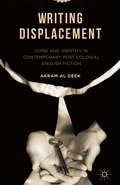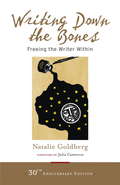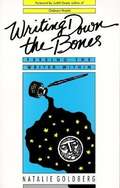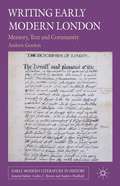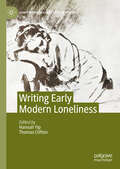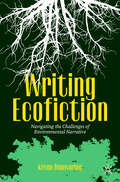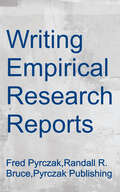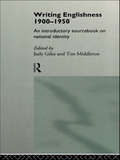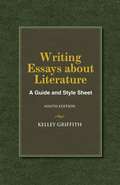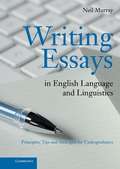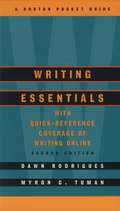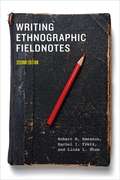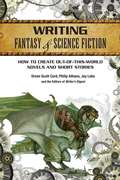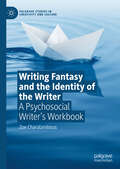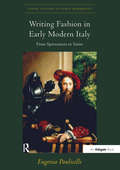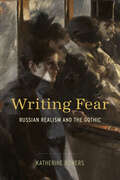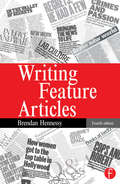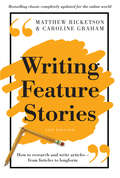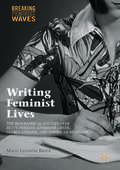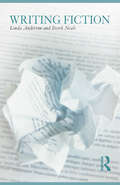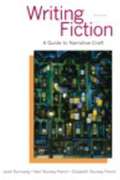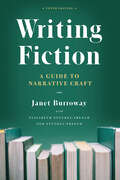- Table View
- List View
Writing Displacement: Home and Identity in Contemporary Post-Colonial English Fiction
by Akram Al DeekUses the Palestinian exilic displacements as a tool and compass to find intersecting points of reference with the Caribbean, Indian, African, Chinese, and Pakistani dispersions, Writing Displacement studies the metamorphosis of the politics of home and identity amongst different migrant nationals from the end of WWII into the new millennium.
Writing Doesn't Have To Be Lonely: 14 Ways to Get the Help of Other People When You Write
by Lawrence WeinsteinOne big reason many people dread to write is that their writing habits don't satisfy their inborn need for company. For many, their writing will go best when they alternate the solitary times with times of companionship and sharing.<P> This is not a book just about the company and help available for writing at school, either. The array of types of help described here should prove valuable in any environment.
Writing Down the Bones: Freeing the Writer Within (Shambhala Pocket Classics Ser.)
by Julia Cameron Natalie GoldbergFor more than thirty years Natalie Goldberg has been challenging and cheering on writers with her books and workshops. In her groundbreaking first book, she brings together Zen meditation and writing in a new way. Writing practice, as she calls it, is no different from other forms of Zen practice--"it is backed by two thousand years of studying the mind."This thirtieth-anniversary edition includes new forewords by Julia Cameron and Bill Addison. It also includes a new preface in which Goldberg reflects on the enduring quality of the teachings here. She writes, "What have I learned about writing over these thirty years? I've written fourteen books, and it's the practice here in Bones that is the foundation, sustaining and building my writing voice, that keeps me honest, teaches me how to endure the hard times and how to drop below discursive thinking, to taste the real meat of our minds and the life around us."
Writing Down the Bones: Freeing the Writer Within
by Natalie GoldbergNatalie Goldberg's word-of-mouth hit has sold well over half a million copies. Goldberg, who has conducted writing workshops for both beginners and professionals all over the United States, sees writing as a practice that helps us comprehend the value of our lives. With insight, humor, and practicality, she inspires writers and would-be writers alike to take the leap into writing creatively and well.
Writing Early Modern London
by Andrew GordonWhat does it mean to write the city? How could the myriad experiences of life in early modern London be translated into textual form? In a detailed study of works ranging from little known manuscript accounts to major canonical texts from the pen of Thomas Middleton and Isabella Whitney, WritingEarly Modern Londonpursues these questions. Arguing that the impulse to record and reflect upon the early modern city was fuelled by the process of religious reformation, it traces the profound impact of these upheavals upon how community was experienced and imagined. The authors studied here show how rites of community were appropriated and re-imagined in texts which responded creatively to the transformation of urban life. Contesting London's future involved contesting the past, and WritingEarly Modern Londondemonstrates how memory became a key cultural battleground, one in which writing itself was implicated, as a far-reaching 'reformation of the archive' challenged the habits of memory within early modern culture. "
Writing Early Modern Loneliness (Early Modern Literature in History)
by Hannah Yip Thomas CliftonThis interdisciplinary collection of ten essays is the first to redefine historical conceptions of “loneliness” in the Western world by exploring its manifestation in early modern textual sources. Contrary to current scholarly consensus that loneliness in Britain was understood as an emotion from the late eighteenth century, only beginning to emerge in its literary form in the writings of the Romantic poets, the contributors in this volume argue that early modern people were capable of complex and conflicting feelings of social and emotional isolation which were expressed in a wide range of writings. Moreover, these products of loneliness continue to resonate poignantly with humanity today.
Writing Ecofiction: Navigating the Challenges of Environmental Narrative
by Kevan ManwaringThis creative writing textbook introduces students to ecofiction: narrative writing that focuses on the environment. Also known as ‘climate fiction’ or ‘cli-fi’, an increasing number of short story writers, novelists and pioneers of emerging forms such as interactive fiction are taking up the call to develop their own creative responses to the climate crisis. This guide explores a cross-section of genres and ways of writing about our world, as well as the ethical and technical challenges involved. It offers a discussion of classic and contemporary texts, literary criticism and creative writing exercises. The book covers a broad range of themes and styles of writing, from works that engage with nature and landscape writing to those that take a more activist approach to climate change. With an awareness of the Global South and the subaltern, the framing of the Anthropocene, wilderness and nature writing is challenged. Each chapter offers a new perspective on ecofiction for the creative writer, with reading suggestions and connections to other writers and texts, and writing activities. Designed for upper-level undergraduate and postgraduate writing modules on the environment, the book is also suitable for independent writers looking to expand their skillset. Featuring 20 interviews with ecofiction authors: Ana Filomena Amaral, Austin Aslan, Denise Baden, David Barker, TC Boyle, Lynn Buckle, Adam Connor, Michelle Cook, Julie Carrick Dalton, April Doyle, Anna Holmes, Somto Ihezue, RB Kelly, Gill Lewis, Anne Mordell, Anthony Nanson, Midge Raymond, Manda Scott, Mary Woodbury, John Yunker. ‘An extensive and enthusiastic guide into the wild and varied worlds of eco-fiction.’ --James Canton, Director of Wild Writing MA, University of Essex, UK
Writing Empirical Research Reports: A Basic Guide For Students Of The Social And Behavioral Sciences
by Fred Pyrczak Randall R. Bruce• Designed for students who will be writing research proposals, reports, theses, and dissertations. • The 15 chapters cover 191 guidelines for effective scientific writing. The guidelines are fully illustrated with easy-to-follow examples. • The guidelines describe the types of information that should be included, how this information should be expressed, and where various types of information should be placed within a research report. • End-of-chapter questions help students master the writing process.
Writing Englishness: An Introductory Sourcebook
by Judy Giles Tim MiddletonWhat did it mean in the first half of this century to say `I am English?' A Practical Sourcebook on National Identity is a unique collection of extracts from writing of the era, all of which in some way raise this question. Drawn from a wide range of sources including letters, diaries, journalism, fiction, poems, parliamentary speeches and government reports, the volume is divided into five sections: * The Ideas and Ideals of Englishness * Versions of Rural England * War and National Identity * Culture and Englishness * Domestic and Urban Englands The editors provide an introduction to each section and conclude with suggested study activities and further reading. It also contains a chronology and bibliography, completing the framework for study. A Practical Sourcebook on National Identity is a fascinating collection which will not only be essential and accessible reading for students, but will also appeal to anyone who has ever asked what it means to become part of a national identity.
Writing Essays About Literature
by Kelley GriffithWidely used in introductory literature courses as a style guide or as a supplement to anthologies, this book provides valuable guidelines for interpreting literature and writing essays. It includes full-length selections as well as essays.
Writing Essays in English Language and Linguistics
by Neil MurrayEnglish language and linguistics shares many of its writing conventions with those of other disciplines, but there are certain features and expectations that distinguish it as a subject. This book is written specifically to help undergraduate students of English language and linguistics develop the art of writing essays, projects and reports. Written by an author with over 30 years' experience of lecturing in the subject, it is a comprehensive and very readable resource and contains numerous discipline-related examples, practice exercises and an answer key. It includes chapters on referencing (including plagiarism, paraphrase and guidance on referencing styles), stylistic issues that often get overlooked, and writing a dissertation. The book offers practical guidance and a layout that guides students as they work though their project. It will be an invaluable reference tool that students can read cover to cover or dip into as and when required.
Writing Essentials
by Sandra Panman Richard PanmanThis book teaches students the kind of writing required for school assignments, written exams, and the workplace. It consists of twelve chapters grouped into three major sections. The first part of the book teaches how to write resumes and business letters. The second section focuses on writing essays using four of the major writing strategies: narration, description, exposition, and persuasion. The last part guides students through writing book reports, short reports, and research papers.
Writing Essentials: A Norton Pocket Guide
by Dawn Rodriguez Myron C. TumanWriting Essentials combines the essentials of grammar, punctuation, mechanics, and documentation with practical suggestions for writing online.<P> From online prewriting, drafting, group workshopping, revising, and editing, to database searching, navigating the Internet, documenting online sources, and designing documents, Writing Essentials offers practical, hands-on advice for using computers throughout the writing process.
Writing Ethnographic Fieldnotes
by Robert M. Emerson Rachel I. Fretz Linda L. ShawIn "Writing Ethnographic Fieldnotes, "Robert M. Emerson, Rachel I. Fretz, and Linda L. Shaw present a series of guidelines, suggestions, and practical advice for creating useful fieldnotes in a variety of settings, demystifying a process that is often assumed to be intuitive and impossible to teach. Using actual unfinished notes as examples, the authors illustrate options for composing, reviewing, and working fieldnotes into finished texts. They discuss different organizational and descriptive strategies and show how transforming direct observations into vivid descriptions results not simply from good memory but from learning to envision scenes as written. A good ethnographer, they demonstrate, must learn to remember dialogue and movement like an actor, to see colors and shapes like a painter, and to sense moods and rhythms like a poet. This new edition reflects the extensive feedback the authors have received from students and instructors since the first edition was published in 1995. As a result, they have updated the race, class, and gender section, created new sections on coding programs and revising first drafts, and provided new examples of working notes.
Writing Ethnographic Fieldnotes, Second Edition
by Emerson Robert M. Fretz Rachel I. Shaw Linda L.In Writing Ethnographic Fieldnotes, Robert M. Emerson, Rachel I. Fretz, and Linda L. Shaw present a series of guidelines, suggestions, and practical advice for creating useful fieldnotes in a variety of settings, demystifying a process that is often assumed to be intuitive and impossible to teach. Using actual unfinished notes as examples, the authors illustrate options for composing, reviewing, and working fieldnotes into finished texts. They discuss different organizational and descriptive strategies and show how transforming direct observations into vivid descriptions results not simply from good memory but from learning to envision scenes as written. A good ethnographer, they demonstrate, must learn to remember dialogue and movement like an actor, to see colors and shapes like a painter, and to sense moods and rhythms like a poet. This new edition reflects the extensive feedback the authors have received from students and instructors since the first edition was published in 1995. As a result, they have updated the race, class, and gender section, created new sections on coding programs and revising first drafts, and provided new examples of working notes. An essential tool for budding social scientists, the second edition of Writing Ethnographic Fieldnotes will be invaluable for a new generation of researchers entering the field.
Writing Fantasy And Science Fiction: How To Create Out-of-this-world Novels And Short Stories
by Orson Scott Card Writer's Digest Books Editors Philip Athans Jay LakeCraft an otherworldly experience for your readers! Do you envision celestial cities in distant, fantastic worlds? Do you dream of mythical beasts and gallant quests in exotic kingdoms? If you have ever wanted to write the next great fantasy or science fiction story, this all-in-one comprehensive book will show you how. Writing Fantasy & Science Fiction is full of advice from master authors offering definitive instructions on world building, character creation, and storytelling in the many styles and possibilities available to writers of speculative fiction.
Writing Fantasy and the Identity of the Writer: A Psychosocial Writer’s Workbook (Palgrave Studies in Creativity and Culture)
by Zoe CharalambousThis book presents the innovative pedagogy of Writing Fantasy: a method for exploring and shifting one’s identity as a writer. The book draws on qualitative research with undergraduate creative writing students and fills a gap in the literature exploring creative writing pedagogy and creative writing exercises. Based on the potential to shift writer identity through creative writing exercises and the common ground that these share with the stance of the Lacanian analyst, the author provides a set of guidelines, exercises and case studies to trace writing fantasy, evidenced in one’s creative writing texts and responses about creative writing. This innovative work offers fresh insights for scholars of creativity, Lacan and psychosocial studies, and a valuable new resource for students and teachers of creative writing.
Writing Fashion in Early Modern Italy: From Sprezzatura to Satire (Visual Culture in Early Modernity)
by Eugenia PaulicelliThe first comprehensive study on the role of Italian fashion and Italian literature, this book analyzes clothing and fashion as described and represented in literary texts and costume books in the Italy of the 16th and 17th centuries. Writing Fashion in Early Modern Italy emphasizes the centrality of Italian literature and culture for understanding modern theories of fashion and gauging its impact in the shaping of codes of civility and taste in Europe and the West. Using literature to uncover what has been called the ’animatedness of clothing,’ author Eugenia Paulicelli explores the political meanings that clothing produces in public space. At the core of the book is the idea that the texts examined here act as maps that, first, pinpoint the establishment of fashion as a social institution of modernity; and, second, gauge the meaning of clothing at a personal and a political level. As well as Castiglione’s The Book of the Courtier and Cesare Vecellio’s The Clothing of the Renaissance World, the author looks at works by Italian writers whose books are not yet available in English translation, such as those by Giacomo Franco, Arcangela Tarabotti, and Agostino Lampugnani. Paying particular attention to literature and the relevance of clothing in the shaping of codes of civility and style, this volume complements the existing and important works on Italian fashion and material culture in the Renaissance. It makes the case for the centrality of Italian literature and the interconnectedness of texts from a variety of genres for an understanding of the history of Italian style, and serves to contextualize the debate on dress in other European literatures.
Writing Fear: Russian Realism and the Gothic
by Katherine BowersIn Russia, gothic fiction is often seen as an aside – a literary curiosity that experienced a brief heyday and then disappeared. In fact, its legacy is much more enduring, persisting within later Russian literary movements. Writing Fear explores Russian literature’s engagement with the gothic by analysing the practices of borrowing and adaptation. Katherine Bowers shows how these practices shaped literary realism from its romantic beginnings through the big novels of the 1860s and 1870s to its transformation during the modernist period. Bowers traces the development of gothic realism with an emphasis on the affective power of fear. She then investigates the hybrid genre’s function in a series of case studies focused on literary texts that address social and political issues such as urban life, the woman question, revolutionary terrorism, and the decline of the family. By mapping the myriad ways political and cultural anxiety take shape via the gothic mode in the age of realism, Writing Fear challenges the conventional literary history of nineteenth-century Russia.
Writing Feature Articles
by Brendan HennessyHennessy's classic text tells you everything you need to know about writing successful features. You will learn how to formulate and develop ideas and how to shape them to fit different markets. Now in its fourth edition, Writing Feature Articles has been fully revised and updated to take into account the changing requirements of journalism and media courses. You will also discover how to exploit new technology for both researching and writing online.Learn step-by-step how to plan, research and write articles for a wide variety of 'popular', 'quality' and specialist publications. Discover more and make the advice stick by completing the tasks and reading the keen analysis of extracts from the best of today's writing.Packed with inspirational advice in a friendly, highly readable style, this guide is a must-have for practising and aspiring journalists and writers.
Writing Feature Stories: How to research and write articles - from listicles to longform
by Matthew Ricketson Caroline GrahamGood writing engages as it informs and feature journalism offers writers the opportunity to tell deep, affecting stories that look beyond the immediate mechanics of who, what, where and when and explore the more difficult-and more rewarding- questions: how and why? Whether you're a blogger, a news journalist or an aspiring lifestyle reporter, a strong voice and a fresh, informed perspective remain in short supply and strong demand; this book will help you craft the kind of narratives people can't wait to share on their social media feeds.Writing Feature Stories established a reputation as a comprehensive, thought-provoking and engaging introduction to researching and writing feature stories. This second edition is completely overhauled to reflect the range of print and digital feature formats, and the variety of online, mobile and traditional media in which they appear.This hands-on guide explains how to generate fresh ideas; research online and offline; make the most of interviews; sift and sort raw material; structure and write the story; edit and proofread your work; find the best platform for your story; and pitch your work to editors.'A wide-ranging, much-needed master class for anyone who tells true yarns in this fast-changing journalistic marketplace' - Bruce Shapiro, Columbia University'Useful and thought provoking' - Margaret Simons, journalist and author'A must read for any digital storyteller who wants to write emotive, engaging, believable content.' - Nidhi Dutt, foreign correspondent
Writing Feminist Lives
by Malin Lidström BrockThis book draws attention to the controversy that surrounds Betty Friedan, Germaine Greer, Gloria Steinem, and Simone de Beauvoir's lives and the important role that their life stories have played in their feminist writing. Directly and indirectly, the four women have contributed to battles over feminism's meaning through autobiographically informed political writing. Inevitably, therefore, their biographers are also participants in these battles, yet not always on the same side as their subjects. Writing Feminist Lives introduces a further fold of nuance into considerations of biography and feminism by showing that the biographers of the four women have made methodological choices that reflect their loyalty to, or their scepticism towards, competing ideological definitions of the exemplary feminist life.
Writing Fiction
by Linda Anderson Derek NealeWriting Fiction offers the novice writer engaging and creative activities, making use of insightful, relevant readings from well-known authors to illustrate the techniques presented. This volume makes use of new versions of key chapters from the recent Routledge/Open University textbook Creative Writing: A Workbook with Readings for writers who are specializing in fiction. Using their experience and expertise as teachers as well as authors, Linda Anderson and Derek Neale guide aspiring writers through such key aspects of writing as: how to stimulate creativity keeping a writer’s notebook character creation setting point of view structure showing and telling. The volume is further updated to include never-before published interviews with successful fiction writers Andrew Cowan, Stevie Davies, Maggie Gee, Andrew Greig, and Hanif Kureishi. Concise and practical, Writing Fiction offers an inspirational guide to the methods and techniques of authorship and is a must-read for aspiring writers.
Writing Fiction: A Guide to Narrative Craft (Ninth Edition)
by Janet Burroway Elizabeth Stuckey-French Ned Stuckey-FrenchIt explores the elements of fiction, providing practical writing techniques and concrete examples, that is personal and non-prescriptive, the text encourages students to develop proficiency through each step of the writing process, offering an abundance of exercises designed to spur writing and creativity, integrates diverse, contemporary short stories in the reading of inspiring fiction goes hand-in-hand with the writing of fresh and exciting stories.
Writing Fiction: A Guide to Narrative Craft (Chicago Guides to Writing, Editing, and Publishing)
by Janet Burroway Elizabeth Stuckey-French Ned Stuckey-FrenchThis updated edition of the classic, comprehensive guide to creative writing features new topics and writing prompts, contemporary examples, and more.A creative writer’s shelf should hold at least three essential books: a dictionary, a style guide, and Janet Burroway’s Writing Fiction. This best-selling classic is the most widely used creative writing text in America, and for decades it has helped hundreds of thousands of students learn the craft. Now in its tenth edition, Writing Fiction is more accessible than ever for writers of all levels—inside or outside the classroom.This new edition continues to provide advice that is practical, comprehensive, and flexible. Moving from freewriting to final revision, Burroway addresses “showing not telling,” characterization, dialogue, atmosphere, plot, imagery, and point of view. It includes new topics and writing prompts, and each chapter now ends with a list of recommended readings that exemplify the craft elements discussed. Plus, examples and quotations throughout the book feature a wide range of today’s best and best-known creators of both novels and short stories.
